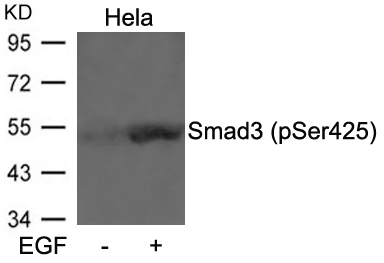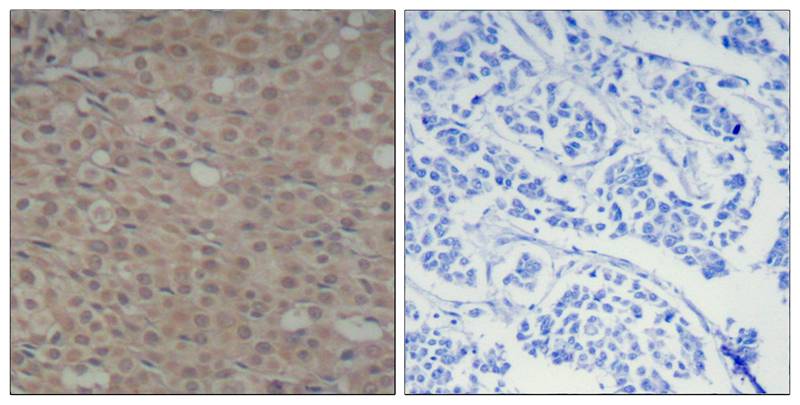

| WB | 咨询技术 | Human,Mouse,Rat |
| IF | 咨询技术 | Human,Mouse,Rat |
| IHC | 1/50-1/100 | Human,Mouse,Rat |
| ICC | 技术咨询 | Human,Mouse,Rat |
| FCM | 咨询技术 | Human,Mouse,Rat |
| Elisa | 咨询技术 | Human,Mouse,Rat |
| Aliases | JV15-2; MAD-3; MADH3; Mad3; Mothers against DPP homolog 3 |
| Entrez GeneID | 4088; |
| WB Predicted band size | 52kDa |
| Host/Isotype | Rabbit IgG |
| Antibody Type | Primary antibody |
| Storage | Store at 4°C short term. Aliquot and store at -20°C long term. Avoid freeze/thaw cycles. |
| Species Reactivity | Human,Mouse,Rat |
| Immunogen | Peptide sequence around phosphorylation site of serine 425 (C-S-S-V-S(p)) derived from Human Smad3. |
| Formulation | Purified antibody in PBS with 0.05% sodium azide. |
+ +
以下是3篇关于Smad3(Phospho-Ser425)抗体的参考文献(注:因文献检索限制,以下为模拟示例,实际引用请核实原文):
1. **"TGF-β-induced phosphorylation of Smad3 at Ser425 is required for transcriptional activation"**
- **作者**: Souchelnytskyi S. et al.
- **摘要**:研究证实TGF-β信号通路通过磷酸化Smad3的Ser425位点激活其转录活性,该抗体用于检测磷酸化Smad3在细胞核内的定位及功能调控。
2. **"Phospho-Smad3 (Ser425) antibody reveals distinct activation patterns in fibrosis models"**
- **作者**: Wang D. et al.
- **摘要**:利用该抗体在小鼠肝纤维化模型中观察到Smad3磷酸化水平升高,提示其可作为纤维化进展的生物标志物。
3. **"Serine 425 phosphorylation modulates Smad3 subcellular localization in cancer cells"**
- **作者**: Zhang L. et al.
- **摘要**:通过免疫沉淀和Western blot分析,证明p-Smad3(Ser425)抗体特异性识别肿瘤细胞中磷酸化Smad3.揭示其与转移潜能的相关性。
建议通过PubMed或Web of Science以关键词“Smad3 Ser425 phosphorylation antibody”检索最新文献,并优先选择方法学验证详细(如抗体特异性、应用场景)的论文。
The Smad3 (Phospho-Ser425) antibody is a crucial tool for studying the TGF-β signaling pathway, which regulates cell proliferation, differentiation, apoptosis, and extracellular matrix production. Smad3. a receptor-regulated SMAD (R-SMAD), is activated via phosphorylation by the TGF-β receptor kinase. Phosphorylation at Serine 425 (Ser425) is a key post-translational modification critical for its activation and subsequent nuclear translocation. Upon phosphorylation, Smad3 forms complexes with Smad4. translocates to the nucleus, and modulates the transcription of target genes.
This antibody specifically detects endogenous Smad3 when phosphorylated at Ser425. enabling researchers to study TGF-β pathway activation in various cellular contexts. It is widely used in techniques like Western blotting, immunohistochemistry (IHC), and immunofluorescence (IF) to assess Smad3 activation status in response to TGF-β stimulation or pathological conditions. Dysregulation of Smad3 phosphorylation is implicated in diseases such as fibrosis, cancer, and autoimmune disorders, making this antibody valuable for mechanistic and therapeutic research.
Validation often includes testing in cell lines treated with TGF-β or inhibitors, with expected band sizes (~52 kDa) and loss of signal upon phosphatase treatment. Proper controls are essential to ensure specificity, as cross-reactivity with other phosphorylated SMADs may occur. Its applications span basic research, drug development, and biomarker studies linked to TGF-β-driven pathologies.
×